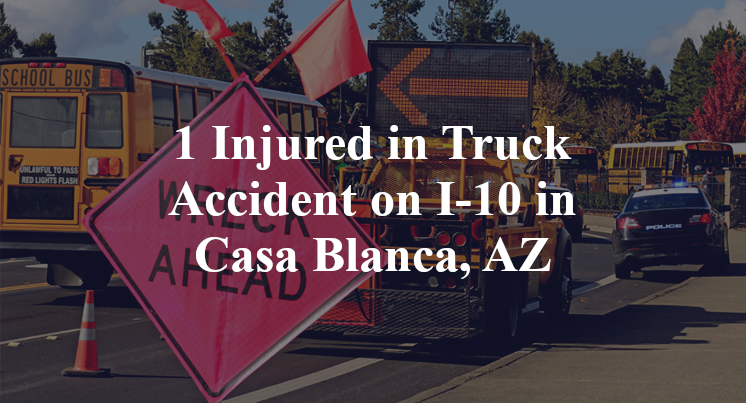1 Injured in Truck Accident on I-10 in Casa Blanca, AZ
Casa Blanca, AZ — October 24, 2025, one person was injured due to a truck accident at approximately 6:30 a.m. along Interstate Highway 10.
According to authorities, one person was traveling in a westbound sedan on I-10 in the vicinity of Bapchule Road when the accident took place.

Officials indicate that, for as yet unknown reasons, the sedan veered left, crossing over the center median and entering the eastbound lanes of the interstate. There, it was apparently involved in a collision with an 18-wheeler hauling a trailer loaded with produce. Photographs of the scene which have been published in the news depict significant damage to the sedan, especially to its front-end and right side.
The person who had been behind the wheel of the sedan reportedly sustained critical injuries over the course of the accident; they were transported to an area medical facility by EMS in order to receive immediate treatment. Additional details pertaining to this incident—including the identity of the victim—are not available at this point in time. The investigation is currently ongoing.
Commentary
When a vehicle crosses a highway median and collides with an oncoming 18-wheeler, the immediate assumption is often that the smaller vehicle is entirely at fault. But from a legal perspective, it’s rarely that simple—especially when the result is life-threatening injury. The key question becomes: Was there anything the truck driver could have done to avoid or minimize the impact?
At this stage, we don’t know why the sedan veered across the median. It could have been due to distraction, a medical emergency, mechanical failure, or a sudden evasive maneuver. That’s a crucial part of the story—but it's only half of it. Once the car entered the eastbound lanes, the 18-wheeler driver had a responsibility to respond appropriately if there was time and space to do so. That’s not speculation—that’s something that can be determined through engine control module (ECM) data, dash cam footage, and physical evidence at the scene, such as skid marks or vehicle positioning.
The damage described—front and right-side impact to the sedan—suggests a glancing blow rather than a full head-on collision, which might indicate the truck driver attempted to steer away. If that’s supported by the evidence, it will matter greatly in determining whether the truck driver acted reasonably under the circumstances. But if the data shows no attempt to brake or evade, further questions will need to be asked—about driver attentiveness, visibility, and reaction time.
Another issue worth examining is the design of the median itself. Was there a barrier to prevent crossovers? If not, was that stretch of highway known to be high-risk for this kind of event? While that doesn’t change what the drivers did in the moment, it could influence how responsibility is evaluated—especially if similar crashes have occurred there before.
Finally, the condition and training of the commercial driver deserve scrutiny. Was the driver alert and properly rested? Was the truck’s cargo—produce, in this case—loaded in a way that allowed for safe handling? In cases I’ve handled, a driver’s ability to steer or brake safely has often depended as much on how the truck was loaded as on how it was driven.
Key Takeaways:
- The core question is whether the truck driver had time and space to react once the sedan entered the eastbound lanes.
- ECM data, dash cams, and crash scene evidence will be essential to evaluating evasive actions or lack thereof.
- The damage pattern suggests an angled collision, possibly indicating attempted avoidance.
- The roadway’s median design may also factor into whether this type of crossover was reasonably preventable.
- Driver attentiveness, fatigue, and vehicle handling (including load balance) must all be reviewed to determine legal responsibility.

“These are essential reads for anyone dealing with the aftermath of a truck wreck”– Attorney Cory Carlson